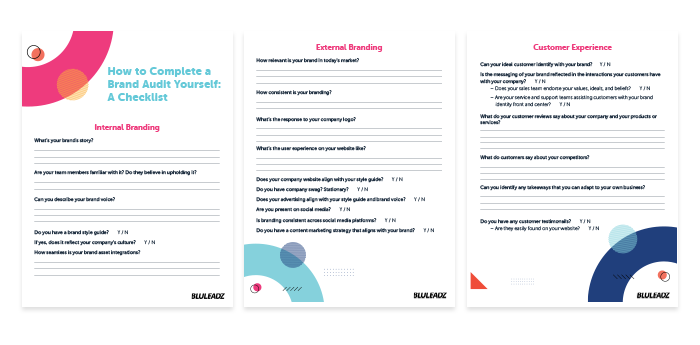There seems to be everlasting brands everywhere in every industry. From household restaurant names to sportswear brands that dominate media, they appear to stand the test of time, a permanent presence in our culture.
But if you look closely, you’ll see minor adjustments, pivots, and rebrands happening all the time. You’ll be hard pressed to find a company that hasn’t amended their image at least once.
Why change something that feels proven true?
Because nothing is perfect, not even your carefully mapped out brand. And the only way to recognize when it’s time to mix things up is to perform regular brand audits.
What Is a Brand Audit?
A brand audit is an evaluation of your brand’s position in your market. The process involves you examining how well your branding efforts are performing and allows you to identify any gaps that may be present.
Think of it like an annual check up. Even if you’re feeling ok, you still perform a physical to make sure that everything’s working alright under the surface.
Why Is Performing a Brand Audit Important?
Your brand needs the same sort of attention and care as your body does.
You may feel that your company’s image is sitting pretty, but market trends change all the time, as do audience interests, and you may actually be falling behind.
Performing a brand audit gives you the opportunity to take a serious look at your company’s image and messaging and learn what third parties actually think.
Does your audience find your brand to be worth engaging with? Do they actually understand your intended messaging or are they perceiving you differently? Do your employees understand it? Do they believe in it?
Brand audits are a great way to identify any brand consistency issues also. They force you to look at your branding across all mediums and make sure they’re all on the same page.
Identifying Brand Assets: What Makes Up Your “Brand?”
This is one of the more common questions when people start assessing their brand. What exactly are you supposed to be looking at?
It’s easiest to think of your brand split into three parts: internal, external, and customer experience.
Each area covers specific elements that reflect your business’ ideals and values.
Internal Branding
- Brand voice
- Brand values
- Company culture
External Branding
- Logo
- Color palette
- Website
- Social media
- Deliverables (e.g., swag, notepads)
Customer Experience
- Sales process
- Support process
- Service process
How to Perform Your Own Brand Audit in 6 Steps
Doing any major project alone can be daunting, especially one as large as a full brand review. But it’s well worth the work if it means keeping your business’ image at the top of its game.
We’ve broken a brand audit down into six easy-to-follow steps that will help you perform a full assessment of your brand.
1. Establish a Framework.
Look at all of your goals and objectives in order to create a decisive framework.
Who are your target personas? What are the strategies you use to appeal to them? What does your marketplace look like at the moment? Any new trends you can leverage?
All of these questions are great places to start so that you can understand where your business is at on a fundamental level.
2. Perform Brand Surveys.
Hearing directly from your customers and employees will provide you more insight on the state of your brand’s influence than any analytics.
Conduct surveys that will pull a variety of quantitative and qualitative feedback for you via phone, email, or on your website. You’ll have a better understanding of your full customer experience, which is important for your audit.
Your customer’s answers will give you a better realized idea of how your audience perceives your brand.
Questionnaires can also provide a customer’s reasoning on picking your brand over another.
3. Examine Your Web Analytics.
When it comes to actually analyzing your data, your website traffic is the obvious place to start. By identifying where your traffic is coming from, whether it be paid or organic channels, you can learn where your brand’s presence is performing strongest.
Does your organic content or advertisements need optimizing? Which channels are underperforming? Why? Are you actually drawing in traffic from your target markets or are they funneling in from elsewhere?
Leverage tools like Google Analytics to examine activity reports, or HubSpot if you’re looking for a more comprehensive and loaded deck to monitor your traffic, CRM, and campaign efforts.
Of course, you’ll want to keep an eye on your conversion rates as well. This part of your brand audit will tell you which types of content are working best and what kind of traffic they’re pulling in.
4. Review Your Social Data.
Examine your social media data with the same attention to detail as you did your website. Social data can offer information on demographics, customer interests, and influencer marketing opportunities.
If you find out that you’re reaching audiences different from your perceived one, then you can adapt your marketing strategies to better relate to them. And understanding their interests outside of your brand may inspire new ideas on outreach and engagement.
5. Analyze Sales Data.
Getting your sales team in on the loop is really important to your branding efforts as well.
By reviewing your sales data, you’ll get a full analysis of the customer journey from start to finish, highlighting any impediments or successes.
This is also a great opportunity to refine your company’s sales playbook. Make sure it’s actually aligned with your brand identity and company goals. Is your sales team truly reflecting your brand’s values? Where are they succeeding? Where can they improve?
6. Evaluate Your Competitor’s Branding.
If you want to be certain that you’re doing something notably different from your competition, then you’ll have to actually look into what they’re doing.
There are tons of competitor analysis tools meant specifically for monitoring your competition’s strengths and weaknesses. Use them to understand where your brand stands in the market and who you’re working against.
Monitor their SEO, SERP rankings, content, traffic, pricing, and the like to get an in depth look at what they’re doing right and how you can put your own spin on it.
Brand Audit Checklist
Keeping track of everything can be tricky, so we came up with a light checklist for you to use when considering everything for your brand audit.
Of course, your own analysis will be a lot deeper and more comprehensive, but this list should help keep you on track.

Download the Checklist Here ➡️➡️➡️
Examples of Brand Audits in Action
There’s no better way to learn than to study and follow the example of those who did it before you. We’ve gathered some brand audit examples to display just how performing one can help your business pivot effectively and see real results.
The following two examples come from established brand names that you likely never would have considered as needing to take stock of their brand positioning.
McDonald’s
Can anyone remember a time when those golden arches weren’t on every corner of every street? Well, there was definitely a gap when fast food chains were just gathering steam and the market was saturated with quick fix lunches.
The McDonald brothers noticed that their restaurants were performing only modestly and viewed as a bit commonplace among their competitors.
In order to figure out what was happening, they performed a brand audit and compared their positioning to their competitors. Turns out, other restaurants were serving pretty much the exact same menu items as them. Customers could get their meals from anyone, so it wasn’t necessary to stop by a McDonald’s specifically.
In order to climb back to the top, the owners set out to identify what they could do that no one else was. It didn’t take them long to learn that faster service was the answer.
McDonald’s reclaimed its throne quickly by instituting a new campaign where they decided to focus their efforts on the products that brought in the most revenue: burgers and french fries.
They built an efficient assembly line that would get customers their favorite meals faster than any of their competitors.
Because they took the time to stop, analyze the market, and examine their brand and services, McDonald’s dominates the game still to this day.
Disney
By the 1980s, Disney had established a cult following and their iconic characters were recognized everywhere. Even in the midst of success though, the company started to notice a shift in their customers’ behaviors.
They had an inkling that it was due to overexposure and saturation. To get confirmation, their marketing team performed a brand audit.
What they found was concerning.
Managers examined all available Disney products and third-party promotions worldwide at the same time that they performed a customer survey.
They found that there were so many products and ads featuring their characters that the marketing didn’t even feel logical anymore. They were just being pasted everywhere with no clear intent or strategy in place.
To make matters worse, customers felt that the company was exploiting their clout and popularity and shoving their brand down their throats. Seeing Disney characters on Tide laundry detergent didn’t encourage buyers to purchase the product; it just made them roll their eyes.
They were overexposed and resentful of it. Marketing managers had no idea that their brand equity was being impacted so negatively.
To right the wrong, Disney built a brand equity team that had a singular focus of managing the brand’s franchising, licensing, and promotional activities. They were meant to maintain a consistent image for Disney that aligned with the customer’s perception of the company as family friendly entertainment.
After the brand audit was completed and a plan of recourse established, co-branding decreased considerably and Disney focused on developing more strategic marketing techniques.
By performing a comprehensive deep dive into your brand’s performance, you’re able to take a closer look at where your company stands in your industry.
That insight will put you on the right path to fully developing your brand into something recognizable and influential.


Micah Lally
I’m a Content Writer at Bluleadz. I’m a big fan of books, movies, music, video games, and the ocean. It sounds impossible to do all of those at the same time, but you’d be surprised by the things I can accomplish.